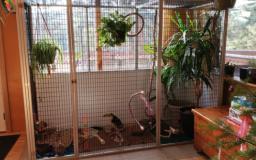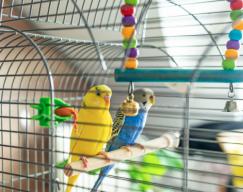Aviary vs. Cage

Which Indoor Setup is Best for Your Bird?
If you’re a bird lover living in South Africa, you already know how rewarding it is to have a feathered companion in your home. Birds are intelligent, social, and full of personality—whether they’re chirping from their perch or snuggling on your shoulder. But one of the most important decisions any bird owner can make is choosing between an aviary and a cage. Both setups fall under the category of Indoor Bird Cages & Aviaries, but each comes with its own set of pros, cons, and considerations.
The right choice depends on your bird’s size, species, activity level, and even your lifestyle and living space. In this guide, we’ll break down the differences between indoor aviaries and cages to help you figure out which is the best fit for your feathered friend. Whether you’re upgrading your current setup or starting fresh, this practical advice will help you create a comfortable, safe, and enriching home environment for your bird.
Understanding the Difference Between Indoor Cages and Aviaries
Before we get into comparisons, let’s quickly define what each term means. While both are used to house birds indoors, their size, structure, and purpose vary quite a bit.
Indoor Bird Cages are the traditional go-to for most pet bird owners. They come in a wide range of sizes, typically suited for one or two birds, and are designed with easy access for cleaning, feeding, and interaction. Cages usually come with perches, food and water bowls, and enough space for light movement, climbing, and toy play. They are ideal for small to medium-sized birds like budgies, cockatiels, or lovebirds.
Indoor Aviaries are much larger enclosures that allow for more freedom of movement. Think of them as the bird equivalent of a full room or walk-in play area. Aviaries are perfect for households with multiple birds or larger species such as parrots and conures. They are designed to mimic a more natural habitat, often featuring branches, swings, ladders, and even indoor plants. An indoor aviary allows your birds to fly and explore more freely while still being safely contained within your home.
Both options fall under the umbrella of Indoor Bird Cages & Aviaries, but the setup that suits you best will depend on your circumstances—and your bird’s!
Which Setup Is Best for Your Bird? Pros and Cons to Consider
Now that we’ve defined the basics, let’s explore the key differences to help you make a more informed choice:
1. Space and Flight
If you have a larger space in your home and want to give your bird room to fly, an indoor aviary is the clear winner. It promotes exercise, reduces boredom, and allows birds to exhibit more natural behaviors like hopping between branches and flapping their wings. Smaller birds benefit just as much from space, but for single-bird homes or those with limited room, a well-equipped cage with out-of-cage playtime can still work beautifully.
2. Socialization and Interaction
Cages typically make it easier to handle your bird and bond with them regularly. You’re more likely to interact with a bird that’s housed close to your living area in a smaller setup. Aviaries, while still indoors, give birds more autonomy, which can be great for their mental well-being—but may require more effort to maintain daily interaction, especially if they have more room to “do their own thing.”
3. Maintenance and Cleaning
Cages are generally easier to clean and maintain because of their size and accessibility. Quick spot-cleaning, daily food and water changes, and a weekly deep clean are usually manageable. Aviaries, on the other hand, require more effort to keep clean due to their size and more complex setups. However, if you have the time (or a great cleaning routine), the trade-off in enrichment might be worth it.
4. Enrichment and Environment
In terms of enrichment, aviaries offer far more variety. You can add ladders, swings, multiple perches, foraging toys, natural wood branches, and even small indoor plants (just make sure they’re bird-safe). Birds kept in aviaries often display fewer behavioral problems like feather plucking or screaming because they’re stimulated by their surroundings. That said, even in a cage, you can provide wonderful enrichment by rotating toys and offering plenty of out-of-cage time. The trick is variety and mental stimulation—something every bird needs, regardless of housing type.
5. Safety and Supervision
Cages tend to be easier to bird-proof and supervise. Smaller spaces mean fewer risks of injury or getting into trouble. In contrast, aviaries need to be carefully designed to ensure there are no escape points or hazards. Always use non-toxic materials, secure latches, and keep electrical items, cords, and harmful substances out of reach. Whether you're using Indoor Bird Cages & Aviaries, safety should always be a top priority.
6. Budget and Setup Costs
Cages are more budget-friendly and readily available at pet stores across South Africa. A good-quality cage, even for a medium-sized bird, is relatively affordable and easy to set up. Aviaries can get expensive quickly, especially if you're building a custom structure or converting a room. However, if you’re planning a home renovation and want to dedicate a space for your birds, an indoor aviary can be a stunning and functional feature in your home.
Which Should You Choose?
At the end of the day, both indoor bird cages and aviaries can be excellent options—as long as they’re set up thoughtfully and tailored to your bird’s needs. If you live in a smaller space, want a closer bond with your bird, and prefer lower maintenance, a cage with plenty of out-of-cage time is probably your best bet. But if you have the space, time, and resources to commit to an aviary, your birds will absolutely thrive in a larger, more enriched environment.
No matter which option you choose, remember that the goal is to provide a home where your bird feels safe, stimulated, and loved. With the right combination of space, enrichment, and care, your bird will reward you with endless personality, beautiful songs, and a companionship that lasts a lifetime.

